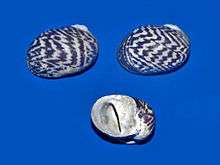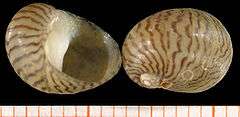Theodoxus danubialis
| Theodoxus danubialis | |
|---|---|
 | |
| Shells of Theodoxus danubialis from Lombardy, on display at the Museo Civico di Storia Naturale di Milano | |
| Scientific classification | |
| Kingdom: | Animalia |
| Phylum: | Mollusca |
| Class: | Gastropoda |
| (unranked): | clade Neritimorpha clade Cycloneritimorpha |
| Superfamily: | Neritoidea |
| Family: | Neritidae |
| Subfamily: | Neritininae |
| Tribe: | Theodoxini |
| Genus: | Theodoxus |
| Species: | T. danubialis |
| Binomial name | |
| Theodoxus danubialis (Pfeiffer, 1828)[2] | |
Theodoxus danubialis is a species of small freshwater snail with an operculum, an aquatic gastropod mollusk in the family Neritidae, the nerites. The species is considered as endangered in Germany, Austria and in the Czech Republic.

Etymology
The Latin name Theodoxus danubialis means "God's gift to the Danube" or "The praise of God in the Danube".
Subspecies
- Theodoxus danubialis cantianus (Kennard & Woodward, 1924) †
- Theodoxus danubialis danubialis (C. Pfeiffer, 1828)
- Theodoxus danubialis stragulatus (C. Pfeiffer, 1828)
Description
Shells of Theodoxus danubialis can reach a diameter of 9–13 millimetres (0.35–0.51 in). These shells are quite flattened, with 3-3.5 whorls. The surface has a characteristic dark brown zigzag drawing on a light background. The width of the zigzag lines is variable. The mouth is round to slightly elliptical. The operculum is pale yellow. The edge is brown and slightly thickened. The body of the snail is bright with a wide base. The antennae are long and pointed.
Distribution
The distribution of this species is Mediterranean and Pontic.[5] It occurs in Austria, Bosnia and Herzegovina, Bulgaria, Croatia, Czech Republic (in Moravia it is critically endangered),[6][7] Germany (in Bavaria only and it is critically endangered),[8] Hungary, Italy, Romania, Slovakia,[7] Slovenia, Ukraine, Serbia and Montenegro.[3][9][10]
Habitat
This species needs clean, oxygen-rich rivers. These snails live on hard benthic substrates,[4] typically rocks or stony ground and feed mainly on diatoms.
Bibliography
- Peter Glöer: Die Tierwelt Deutschlands. Mollusca I Süßwassergastropoden Nord- und Mitteleuropas Bestimmungsschlüssel, Lebensweise, Verbreitung. 2. neubearb. Aufl., 327 S., ConchBooks, Hackenheim 2002 ISBN 3-925919-60-0
- Rosina Fechter und Gerhard Falkner: Weichtiere. 287 S., Mosaik-Verlag, München 1990 (Steinbachs Naturführer 10) ISBN 3-570-03414-3
- Jürgen H. Jungbluth und Dietrich von Knore: Trivialnamen der Land- und Süßwassermollusken Deutschlands (Gastropoda et Bivalvia). Mollusca, 26(1): 105-156, Dresden 2008 ISSN 1864-5127
References
- ↑ 2006 IUCN Red List of Threatened Species. <www.iucnredlist.org>. Cited 14 June 2007.
- ↑ Pfeiffer, 1828. Naturgeschichte deutscher Land- und Süsswasser-Mollusken. Vol. 3 (1828): 84 pp. + 8 tables. Weimar. (Landes-Industrie-Comptoir).
- 1 2 Biolib
- 1 2 PETER GLÖER and VLADIMIR PEŠIĆ The morphological plasticity of Theodoxus fluviatilis (Linnaeus, 1758) (Mollusca: Gastropoda: Neritidae)
- ↑ (Slovak) Lisický M. J. (1991). Mollusca Slovenska [The Slovak molluscs]. VEDA vydavateľstvo Slovenskej akadémie vied, Bratislava, 344 pp.
- ↑ Red List of the molluscs (Mollusca) of the Czech Republic
- 1 2 (Czech) Horsák M., Juřičková L., Beran L., Čejka T. & Dvořák L. (2010). "Komentovaný seznam měkkýšů zjištěných ve volné přírodě České a Slovenské republiky. [Annotated list of mollusc species recorded outdoors in the Czech and Slovak Republics]". Malacologica Bohemoslovaca, Suppl. 1: 1-37. PDF.
- ↑ Glöer P. & Meier-Brook C. (2003) Süsswassermollusken. DJN, pp. 134, page 108, ISBN 3-923376-02-2
- ↑ Fauna europaea
- ↑ WMSDB – Worldwide Mollusc Species Data Base